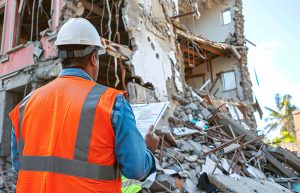Demolition projects are a vital part of the construction and urban development process, enabling old or unsafe buildings to be removed and new structures to take their place. However, the very nature of demolition—working with unstable buildings, heavy machinery, hazardous materials, and unpredictable environments—makes it a high-risk activity. Health and safety protocols play a crucial role in ensuring that these projects are carried out without harm to workers, the public, or the surrounding environment.
In this blog, we will explore the critical role of health and safety in demolition projects, highlight the key risks involved, and outline best practices for maintaining a safe demolition site.
Why Health and Safety Matter in Demolition Projects
Demolition, unlike new construction, often deals with structures that are deteriorating, structurally unsound, or filled with hazardous materials. This creates unique challenges that must be addressed through stringent health and safety measures. Failure to prioritize safety can result in severe accidents, legal liabilities, and even fatalities.
The key reasons why health and safety are essential in demolition projects include:
- Worker Protection: Demolition workers face various hazards, including exposure to dangerous materials like asbestos, the risk of falling debris, and accidents involving heavy machinery. Protecting the workforce is the primary reason for implementing strict health and safety measures.
- Public Safety: Demolition often takes place in urban or densely populated areas. Without proper safety measures, the public may be at risk from flying debris, noise pollution, and even structural collapses.
- Environmental Responsibility: Demolition can release hazardous substances into the environment, such as asbestos fibres or lead paint. Proper disposal of materials and site management are essential to prevent environmental contamination.
- Regulatory Compliance: Governments impose strict regulations on demolition projects to ensure safety. Non-compliance can lead to hefty fines, legal action, and project delays, making adherence to health and safety guidelines a legal and financial necessity.
Key Health and Safety Risks in Demolition Projects
While all demolition projects present their own unique challenges, certain risks are common to the majority of projects. Below are some of the most significant health and safety risks and how they can be mitigated.
1. Structural Collapse
The demolition of a building often involves weakening or removing key structural elements, which increases the risk of an unexpected collapse. Without careful planning and execution, workers and nearby structures can be severely affected.
Mitigation Strategies:
- Pre-demolition Surveys: A structural engineer should inspect the building to assess the risk of collapse and identify safe demolition methods.
- Controlled Demolition Techniques: Using controlled demolition, such as implosion, helps ensure that the building collapses in a planned, safe manner.
- Safety Zones: Establish exclusion zones around the site to keep unauthorized personnel at a safe distance from potential collapse areas.
2. Hazardous Materials Exposure
Older buildings often contain dangerous materials like asbestos, lead, and chemicals. If not handled properly, these substances can pose severe health risks to workers and the public.
Mitigation Strategies:
- Asbestos Surveys: Conduct thorough surveys to identify any asbestos-containing materials (ACMs) in the building. Certified professionals should remove these materials before demolition begins.
- Personal Protective Equipment (PPE): Workers must be provided with PPE, including respirators, gloves, and protective suits, to prevent direct exposure to hazardous substances.
- Safe Disposal: Hazardous materials need to be disposed of following strict regulations to prevent environmental contamination and public health risks.
3. Heavy Machinery Accidents
Demolition projects rely heavily on machinery like excavators, cranes, and bulldozers. While these machines make the job easier, they also introduce significant risks if not operated correctly.
Mitigation Strategies:
- Operator Training: Ensure that all operators are fully trained and certified to handle the specific machinery used on the site.
- Regular Equipment Maintenance: Regularly inspect and maintain machinery to prevent malfunctions that could lead to accidents.
- Clear Communication: Establish clear communication protocols between machine operators and ground workers to avoid accidents, such as collisions or getting caught in moving parts.
4. Falling from Heights
Many demolition projects require workers to operate at height, whether on scaffolding, rooftops, or ladders. Falls are one of the leading causes of injury and death on construction sites, including during demolition.
Mitigation Strategies:
- Use of Fall Protection Gear: Workers operating at heights must wear appropriate fall protection equipment, such as harnesses and lanyards.
- Scaffolding Safety: Erect scaffolding according to strict safety standards, and regularly inspect it for damage or wear.
- Ladder Safety: Train workers on proper ladder use and ensure that all ladders are securely placed before use.
5. Noise and Vibration Hazards
Demolition activities, especially when using heavy machinery, generate significant noise and vibration. These factors can cause long-term hearing damage to workers and may disturb the public, especially in urban areas.
Mitigation Strategies:
- Hearing Protection: Workers should wear hearing protection, such as earplugs or earmuffs when working in high-noise areas.
- Noise Control Measures: Implement noise-reduction techniques, such as the use of quieter machinery or sound barriers, especially if the project is in a residential area.
- Vibration Monitoring: Monitor the effects of vibration on nearby structures to avoid damage. Excessive vibration can lead to unplanned structural collapses, especially in buildings adjacent to the demolition site.
Best Practices for Health and Safety in Demolition Projects
Implementing a comprehensive health and safety plan is essential for any demolition project. Below are some best practices to ensure that risks are minimized and that the project is carried out safely.
1. Conduct a Detailed Risk Assessment
Before beginning any demolition work, conduct a detailed risk assessment to identify potential hazards. This should include an evaluation of the building’s structural integrity, hazardous materials, proximity to other buildings, and the equipment that will be used. Based on the assessment, a safety plan should be developed and shared with all workers.
2. Develop a Site-Specific Safety Plan
Each demolition project is unique, requiring a customized safety plan. The plan should outline:
- The methods of demolition.
- The PPE requirements.
- Procedures for hazardous materials removal and disposal.
- Emergency protocols, including evacuation routes and first aid procedures.
3. Use Qualified Professionals
The demolition process involves many specialized tasks, from asbestos removal to operating heavy machinery. Hiring trained and certified professionals for these tasks ensures that they are carried out safely and according to regulatory standards.
4. Communication and Training
Effective communication is key to maintaining safety on a demolition site. Ensure that all workers are trained on the safety protocols and that there are clear lines of communication between teams. Regular safety briefings and toolbox talks can help reinforce safety messages.
5. Continuous Monitoring and Supervision
Supervision is critical to ensuring that safety measures are followed throughout the project. Appoint safety officers or site managers to oversee the work and ensure that all safety protocols are adhered to. Continuous monitoring allows for real-time adjustments to the safety plan if new hazards emerge.
Conclusion
Health and safety are at the core of any successful demolition project. By prioritising worker protection, public safety, and environmental responsibility, you not only comply with legal regulations but also minimize the risk of accidents, injuries, and costly delays.
Whether dealing with structural collapses, hazardous materials, or machinery-related risks, comprehensive safety planning is essential. Through detailed risk assessments, proper training, and the use of qualified professionals, you can ensure that your demolition projects are completed safely and efficiently. Remember, safety is not just a legal requirement—it’s a moral and professional obligation that benefits everyone involved.




